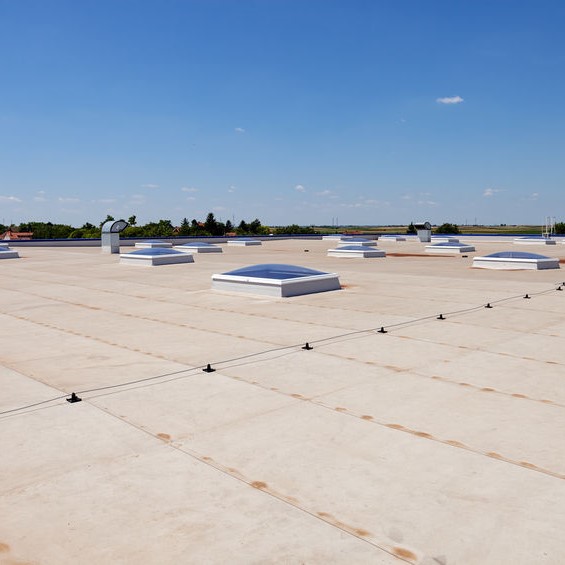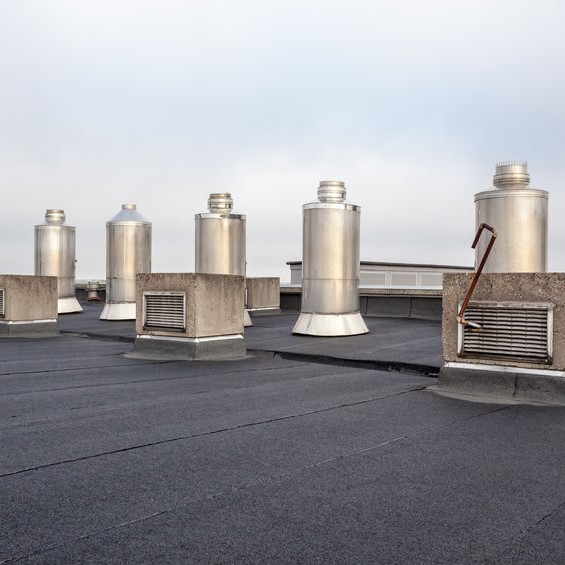
Flat roofing for commercial properties
Single ply roofing is the most common of all commercial building roofing materials. Why? Because single ply roofing has proven to be the best for flat or low sloped roofs when it comes to durability, long-lasting, water resistant, and weather resistant. Think of what the roof of your home goes through and apply that to a commercial building that is 10 times bigger. A strong roofing material is a must.
Single-ply roofing is a category of pre-fabricated, compounded plastic-derived material, flexible sheets that cover flat and low-sloped buildings to provide protection against the elements. These single ply roofing membranes are factory manufactured and meet strict quality control. They can be installed and attached in different methods.
Over the past thirty years, single-ply roofing has replaced older flat roofing materials like tar paper and has become commercial roofing contractors and commercial building owners preferred roofing material. When single ply roofing material is installed by a professional that knows how to install single ply roofing, you get an essential advantage with the high level of durability, flexibility, and strength over the traditional roofing materials. There three most used single ply roofing materials are:
- EPDM – Ethylene Propylene Diene Monomer, the preferred choice for decades
- PVC – Polyvinyl Chloride, popular and time tested, used for decades
- TPO – Thermoplastic Polyolefin, considered the best single ply roofing membrane
A big concern for any commercial or industrial building owner is, “Is it OK to walk on flat roofs?”, and when it comes to single ply roofing material, that is an important fact in choosing the right material. So, can you walk on single ply roofing?
While single-ply roofing membranes are popular for commercial structures, and can withstand foot traffic, this flexible, lightweight materials are easily punctured if certain precautions aren’t followed. Whether it is the roofing crew or your maintenance crew because there isn’t a hard layer of protection, dropped tools, loose screws, even gravel can get pushed into the membrane and create holes, leaving the single ply roofing vulnerable for leaking.
Prevention is the best solution for single ply roofing. The following tips will provide some puncture resistance:
- Keep tree limbs trimmed back.
- Place protective mats in foot traffic areas.
- Keep debris cleared off the roof system.
- Remove loose equipment not being used.
- Install warning signs to keep area clean while working.
How do you fix a single ply membrane?
Accidents happen, even high up on a commercial structure with single ply roofing. So, when your roofing system gets punctured or a tear, is it repairable? Absolutely! A professional roofing contractor can quickly repair your single ply roofing in four steps:
- Clean the area surrounding the damage
- Apply a single ply roofing adhesive to prepare for bonding
- Cut a piece of like-roofing membrane two inches bigger than the damaged area
- With an adhesive or hot-air gun, bond the new piece to the surrounding membrane

What are the disadvantages of using a single ply roof membrane?
Single ply roofing membranes can be installed by being ballasted or chemically adhered to provide a commercial structure protection from the elements. The three main types we mentioned earlier, EPDM, PVC, and TPO all have benefits to offer, all have disadvantages too, there is not 100% perfect single ply roofing material. The main single ply roofing pros and cons are as follows:
Pro: Proven Record
EPDM single ply roofing has been around for more than sixty years and is still used today. There have been numerous laboratory tests and field studies performed with results tracked. TPO has a bigger share of the commercial market but is newer and doesn’t have a proven track record.
Pro: Insulation Materials
Single-ply roofing doesn’t include insulation, allowing the customer to choose from a variety of options. Some of the insulation options available are:
- Polyisocyanurate – The most common used, although expensive, the high R-value gets that money back faster over time.
- Expanded Polystyrene – Per dollar, this insulation has the highest R-value and can be used in the roofing, flooring, and walls, and doesn’t retain water.
- Extruded Polystyrene – A choice between EPS and Polyiso with pricing and performance, offering a semipermeable quality with a perm rating of one.
Pro: Reflective or Retentive Properties
TPO single ply roofing is known as the white roof, is rapidly growing in popularity is a highly reflective single ply roofing material. EPDM is the black roof and is a high-performance rubber compound that provides superb heat retention and weatherability, a great benefit for structure in cooler climates.
Pro: Easy Installation
TPO Installation doesn’t have the complexities of spray polyurethane foam roofing, making it a relatively simple installation. Once the preparation of the existing substrate is completed, the insulation layers are installed by ballasting, adhesive, or mechanical fastening. Then a cover board is installed. EPDM single ply roofing is joined with seam tape and TPO single ply roofing is melted to the membrane with a hot-air gun.
Pro: Flexible and Lightweight
Single ply roofing material has multiple layers, with a choice in thickness but remains to be flexible and lightweight. This allows the roofing contractor the ability to accommodate any uniqueness to a roof design and leaves it flexible for contracting and expanding of the structure.
Con: Easily Punctured
While the flexibility and lightweight of single ply roofing is pro, it is also a con because of the ease in being punctured or torn. There is no hard layer of protection from dropped tools, loose screws, or gravel getting pushed into the single ply roofing membrane, which allows it to be damage with holes and tears, leaving it vulnerable to leaking.
Con: Roofing Accessories
Most commercial flat roofing has accessories installed like the HVAC system, skylights, assorted venting, and more. These penetrations require the roofing contractor to approach the installation different by cutting the membrane in smaller sections instead of simply rolling the membrane out in one large piece. This can minimize the waterproofing around the penetrations and in the seams.
Con: UV Rays
Flat roofing is exposed to UV rays directly shining on the surface which can quickly degrade the adhesive, leaving the seams vulnerable for leaks. A puncture or tear will allow the UV rays directly to the adhesive layer, causing more damage and deterioration.
With this information, you can be better prepared to discuss the options for your commercial structure as to what type of single ply roofing is best. It is always best to get 2 to 3 written estimates and review the policies of warranty. Call 816-896-4195 today for your single ply roofing installation in Grain Valley and Kansas City, MO.